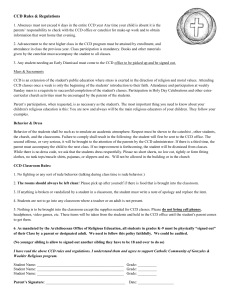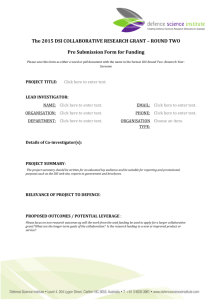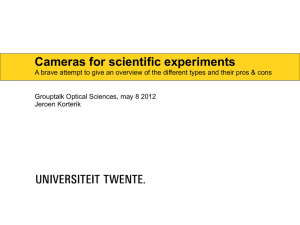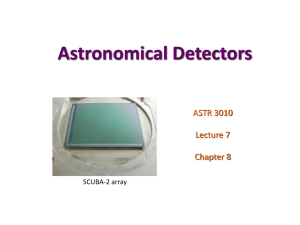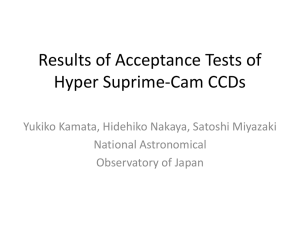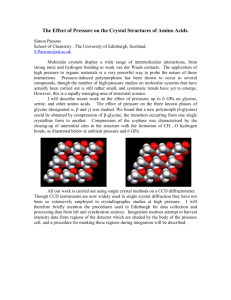Implementation of two multi-channel ASICs for CCD readout
advertisement
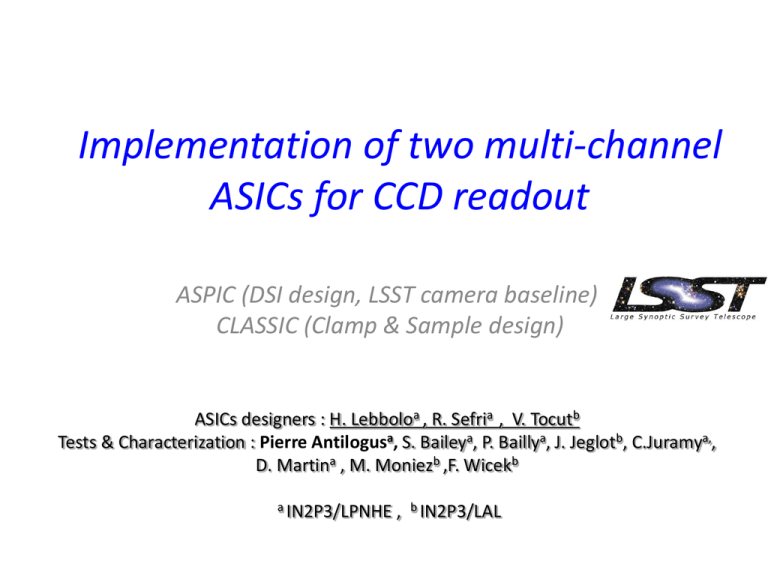
Implementation of two multi-channel
ASICs for CCD readout
ASPIC (DSI design, LSST camera baseline)
CLASSIC (Clamp & Sample design)
ASICs designers : H. Lebboloa , R. Sefria , V. Tocutb
Tests & Characterization : Pierre Antilogusa, S. Baileya, P. Baillya, J. Jeglotb, C.Juramya,,
D. Martina , M. Moniezb ,F. Wicekb
a IN2P3/LPNHE
, b IN2P3/LAL
LSST Focal Plane
189 Science CCD
4k X 4k 10mm pixels
= 3 x109pixels
for a focal plane of
- 64 cm de diameter
- 9.6 Deg 2
3X3
CCD
“RAFT”
The CCD are split in 16
segments of 1 M pixels :
2s readout time for the
full focal plane => 500kHz
Science Rafts (9 CCD):
autonomous, fully
testable 144 Mpixel camera.
1 Raft ~ 1/2 Megacam at CFHT
LSST camera = 21 rafts
15/10/09 - Detectors for Astronomy 2009
Corner rafts :
guiding and wavefront sensing
ASICs for CCD readout
2
LSST camera readout system
189 Science CCD x 16 outputs = 3024 readout channels
Request a compact readout chain inside the cryostat
The topic of this talk : ASIC for FE CCD readout
15/10/09 - Detectors for Astronomy 2009
ASICs for CCD readout
3
LSST Front End : ASIC for CCD readout specifications
Requirements :
• CCD readout at 500 kHz (nominal) to 250 kHz
• Noise : ~5nV / √Hz (or 7µV rms noise for 500ns integration )
( ~2 e- to be compared to 5 e- read noise for the whole CCD Chain)
• Power dissipation at cryo temperature : 20-25 mW/channel
• Crosstalk : 10-4 level ( 0.01% (goal) - 0.05% (max) )
• 90Keˉ Full Well capacity (150Keˉ max)
• 0.5% linearity ( defined over 0 to 100 000 eˉ full well )
• Differential outputs
• Output Load : 50pF // 1 k Ω
• Power Supply 0/5V with respect to reference = 2.5 V
• Running temperature 173K
Our initial worry :
Does a 8 channels ASIC will have the required low level crosstalk
15/10/09 - Detectors for Astronomy 2009
ASICs for CCD readout
4
Analog signal processing of CCD : DSI or C&S
The standard technique for analog
signal processing of CCDs, is
“Correlated Double Sampling”. It has
been commonly implemented using
one of the following schemes:
• “Dual Slope Integrator” (DSI )
• “Clamp & Sample” (C&L) .
Vout
t
reset feedthrough
Reference level
signal level
Charge dump
The first prototype implemented for LSST , the Analog Signal Processing
ASic , (ASPIC I ), was a 8 channels ASIC with :
• 4 DSI channels : The reference design for LSST is DSI.
• 4 C&S channels : As we had a C&S design almost “ready” and
considering the higher complexity of the DSI design and the R&D/unknown
related to the crosstalk.
15/10/09 - Detectors for Astronomy 2009
ASICs for CCD readout
5
Analog signal processing of CCD : Dual Slope Integrator (DSI)
Noise % 1/ sqrt (Tintegration)
5K
100pF
5K
-
5K
outp
"diff DSI" outp
inp
+
10K
+
-
Vref
CDS
8k 2p
8p
Vref
(switches)
2k
10K
100pF
Vref Vref
-
5K
inm
"diff DSI" outm
outm
+
Vref
Clamp
1 gain , 2 integration constant time
15/10/09 - Detectors for Astronomy 2009
ASICs for CCD readout
6
Analog signal processing of CCD : Clamp and Sample (C&S)
clamp Switch
Noise % 1/ sqrt (Tau)
With Tau = filter at the output of the C&S
The “usage wants” Tau to be of the order 1/10 of the CCD signal width
On ASPIC I , we had no filtering at the output of the C&S ( Tau ~ 35 ns )
15/10/09 - Detectors for Astronomy 2009
ASICs for CCD readout
7
Analog signal processing of CCD :ASPIC I
•Techno : CMOS 0.35µ 5V
•Vendor : AMS
•Package : CQFP100
TEST
Require
DSI
C&S
Crosstalk
0.05 %
0.007 %
0.02 %
~0.5%
Goal 0.01%
Linearity
0.5 %
+/-0.2 %
Power
per
channel
25 mW
48.5 mW (22o C)
Noise
7 µV
19.04µV (Tint=500ns) 12µV (22o C)
10µV (-100o C)
Cold
Works at 100oC
24.3 mW
3.8mm
( -100oC)
4 DSI channels
Tested down to -170oC
4 C&L channels
15/10/09 - Detectors for Astronomy 2009
ASICs for CCD readout
2.7mm
8
Analog signal processing of CCD : ASPIC I Conclusion
The first prototype has demonstrated
DSI and C&S : implementation in a multi channel Integrated Circuit work at
low temperature with low crosstalk
DSI : Good fit between measurements and simulations (based on an equivalent
circuit using a linearized schematic to replace CDS switches)
C&S : gave competitive results
ASPIC II optimise Noise & Power and add functionalities
Proto 1 - Noise density simulations & Measurements
50
45
DSI
40
µV
35
30
Noise measurement LPNHE
25
Noise measurement LAL
20
Noise simulation
15
10
5
0
0
0,05
15/10/09 - Detectors for Astronomy 2009
0,1
1/SQRT(Tint)
0,15
ASICs for CCD readout
9
Analog signal processing of CCD :ASPIC II
3 input amplifier gains : 2.5 – 5 – 7.5
to deal with CCD gain spread.
3 integration time constants : 500ns – 1µs – 1.5µs
to deal with CCD readout frequency.
Idle mode : DC current reduction by a factor of 1.000
•Techno : CMOS 0.35µ 5V
•Vendor : AMS
•Package : CQFP100
• 8 DSI channels
baseline : { gain 5 + 500ns integration time}
15/10/09 - Detectors for Astronomy 2009
ASICs for CCD readout
10
ASPIC II : Layout and improvement
LVDS inputs : 1.2V +/- 200mV terminated
with 100 ohms
CDS clocks: clamp + integrator
reset + signal integration + reference
integration
CMOS inputs: 0V / +5V (compatible with
3.3V signals)
input gain and integration time select
Improvement compared to ASPIC I :
Noise:
1/f noise reduced : amplifier first
stage optimization
RC Input gain : noise source
Power consumption :
Source identified : amplifier
output stage.
15/10/09 - Detectors for Astronomy 2009
ASICs for CCD readout
11
ASPIC II : Simulation
Noise simulations of ASPIC 2 @ -100°C
6µV RMS noise for an Integration Time of 500ns
Noise
0.1%
Linearity
-0.15%
15/10/09 - Detectors for Astronomy 2009
ASICs for CCD readout
12
ASPIC II : first results
TEST
Require
Crosstalk
0.05 %
DSI
(simul)
DSI
(measure)
-
0.02 %
Goal 0.01%
Linearity
0.5 %
Power
per
channel
25 mW
Noise
Goal 20 mW
7µV
( -100oC)
15/10/09 - Detectors for Astronomy 2009
+/-0.1 %
+/-0.1%
25 mW (27o C)
20 mW(-100o C)
26 mW (22o C)
8 µV (27o C)
9 µV (22o C)
(Tint=500ns)
ASICs for CCD readout
13
“study on the side” : C&S version II ( CLASSIC )
•
•
•
•
•
Pin to pin compatible with ASPIC 2
3 bit programmable gain input amplifier
4 bit programmable output time constant filter to
match the readout frequency (tau = 8ns to 392ns )
Two differents C&S topologies (simulated noise ~ 1 efor a power < 20 mW/channel and 500 kHz CCD
readout)
Idle mode
15/10/09 - Detectors for Astronomy 2009
ASICs for CCD readout
•Techno : CMOS 0.35µ 5V
•Vendor : AMS
•Package : CQFP100
• 8 C&S channels
14
Conclusion
-
-
-
We made a 8 channels ASICs with low crosstalk ,
low noise , low power, fast readout, for analog
signal processing of CCD using CMOS 0.35µ 5V:
- Such ASICs are needed for a large focal
plane like the LSST one
- If you are tired of fighting against « setup
noise » , such ASIC with differential output
directly in your cryostat could make your life
so easier ….
If you were expecting a “3 sigma effect” between
DSI and C&S (or C&S and DSI) …looks like it
was the wrong talk … still the difference is
always in the detail ( crosstalk vs time , ultimate
readout speed, connection to CCD …) , and we
are far to have completed the characterization of
our second generation of prototypes .
For LSST, we now look forward to plug a LSST
prototype CCD on our ASPIC II …
15/10/09 - Detectors for Astronomy 2009
ASICs for CCD readout
15

